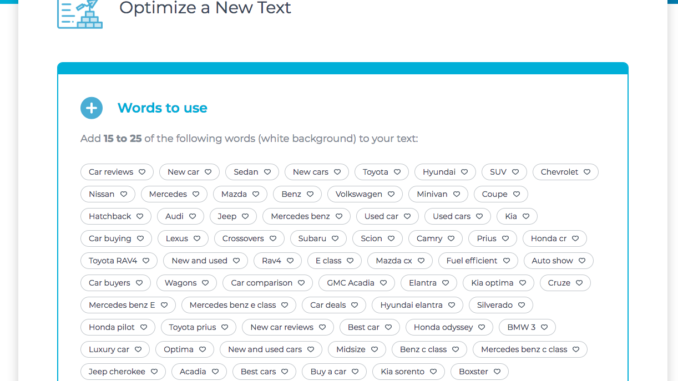
When you do your keyword research, you take pains to choose keywords that best represent what you’re offering. You hope that someone searching with those keywords will convert. But you need to do more than hope. You need to think like a searcher.
What is Search Intent?
I’ve used this phrase before, and I’m sure you’ve heard it elsewhere as well. In this context, it means asking a few pointed questions about the keywords for which you’re trying to rank. Basically, you want to understand the intentions of someone searching with those keywords. Are they just looking, or do they plan to buy something?
Say you’re trying to sell cars. For most people, a car is a major purchase. You don’t just set out one day and buy a car that afternoon; you do some research, think about your needs, consider what you can afford, and so forth. As you might expect, the keywords searchers use reflect this process.
This means that you can tell, with some degree of accuracy, where a searcher is in their buying process (and possibly how likely they are to convert) by looking at the keywords they use. If you try to rank for the kinds of keywords used by a searcher who is close to buying, you should see more conversions. On the other hand, as you’ll see a bit later, you might not want to entirely rule out ranking for keywords a searcher might use earlier in the process.
With voice search on the rise, satisfying searcher intent and meeting the users’ immediate needs becomes the SEO top priority.
Search Intent and Semantic Search
Semantic search is the ability of search engines (Google) to identify:
Query context
The relationships between concepts
Searcher intent
As you can see, search intent is very much connected to both the keyword context and how the keyword is perceived in relation to other related concepts.
There’s a tool called Text Optimizer that extracts Google’s featured snippets and, using semantic analysis, identifies related concepts and entities to help you optimize for searcher intent:
Implementing Search Intent Concept to Marketing
Take a searcher using the key phrase “car reviews.” This searcher has probably decided that they need a car, but they’re still comparison shopping. They haven’t decided what they want to buy yet, so it will be quite some time – maybe even months – before they make their purchase. Contrast this with the searcher who uses the key phrase “fast auto financing.” For whatever reason, this person wants or needs to buy a car, and quickly. They will probably convert much faster than someone who is searching for “car reviews.”
Typically, searchers use longer and more specific terms when they’re closer to making a purchase. They’ve already sifted through the other options, and narrowed their choices down to the two or three products that best suit their situation. Consider the difference between the key phrases “Toyota dealers” and “Toyota Camry four door V-6 engine.” Both searchers may be getting ready to go shopping, but the second one knows what make and features she wants.
This would be an appropriate place for me to bring up a concept that’s more than 100 years old: the purchase funnel. In its most basic form, it posits that consumers go through four stages when getting ready to make a purchase:
Awareness of the existence of a product or service.
Interest, or actively expressing an interest in a product (This is where lead generation comes into play).
Desire to own a particular brand or product.
Action, or actually making the purchase of a chosen product.
I want to emphasize here that this is the simplest version of the purchase funnel. There are many others, and a number of marketers believe that the purchase funnel, as it has been traditionally formatted, is dead. In their view, social media has changed the purchase funnel into more of a consumer’s journey, and even after purchasing a product, the experience leads the consumer to build expectations for their next “consumer decision journey” based on how this one went.
What happens instead is that consumers often start out considering a narrower list of brands for a particular product. So if I were shopping for a car, I might consider Toyota, Ford, and Hyundai brands. Once I start asking my friends and doing research online – “active evaluation” stage – I might actually widen my selection. I chat up a friend who’s been very happy with his Kia, and I read some study that tells me Chrysler vehicles have gotten more reliable over the past five years, and Volkswagen brings back a car line I thought I’d never get to drive… well, you get the idea.
What, exactly, does this mean to you? You might need to plan for two different keyword campaigns:
one to reach out to consumers just starting to actively consider purchasing your product,
another one to get those who are ready to buy.
That first keyword campaign may also need a social component to make you visible in the places that a savvy, searching consumer will see you – not just in the search engines, but on social sites. An effective digital marketing campaign is well-integrated and takes many channels into account.
The real challenge involves presenting a searching consumer with the kind of information they’re looking for at a particular stage of their decision process. That’s not easy, and it’s beyond the scope of this article. But if you keep in mind the searcher’s intent in choosing certain keywords, and consider what kinds of questions they’re asking when they use them, you stand a better chance of converting them. All you need to do is give them the answers they’re looking for. Good luck!
The post Consider Searcher Intent in Your Keyword Research appeared first on SEO Chat.
Source: SEO Chat
Link: Consider Searcher Intent in Your Keyword Research



Leave a Reply